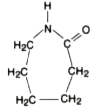Which of the following polymers can be made by cationic addition polymersation mechanism?
PVC
PP
HDPE
LDPE
The correct Answer is:B
To determine which of the given polymers can be made by cationic addition polymerization mechanism, we will analyze each option provided.
1. Understand Cationic Addition Polymerization:
- Cationic addition polymerization is a type of chain-growth polymerization where a cationic initiator reacts with a monomer to form a reactive species. This reactive monomer can then react with other monomers to form a polymer.
2. Evaluate Each Polymer Option:
- Option 1: PVC (Polyvinyl Chloride):
- PVC is synthesized through radical polymerization, not cationic polymerization. Therefore, this option does not fit the criteria.
- Option 2: PPE (Polyphenylene Ether):
- PPE can be synthesized through cationic polymerization. This option is a candidate for our answer.
- Option 3: HDPE (High-Density Polyethylene):
- HDPE is produced through Ziegler-Natta catalytic polymerization, which is not cationic polymerization. Thus, this option is not correct.
- Option 4: LDPE (Low-Density Polyethylene):
- Similar to HDPE, LDPE is also produced via Ziegler-Natta catalytic polymerization and not cationic polymerization. Therefore, this option is also incorrect.
3. Conclusion:
- Among the options provided, only PPE can be made by cationic addition polymerization mechanism.
Final Answer:
- The polymer that can be made by cationic addition polymerization mechanism is PPE (Polyphenylene Ether).
- Cationic addition polymerization is a type of chain-growth polymerization where a cationic initiator reacts with a monomer to form a reactive species. This reactive monomer can then react with other monomers to form a polymer.
- Option 1: PVC (Polyvinyl Chloride):
- PVC is synthesized through radical polymerization, not cationic polymerization. Therefore, this option does not fit the criteria.
- Option 2: PPE (Polyphenylene Ether):
- PPE can be synthesized through cationic polymerization. This option is a candidate for our answer.
- Option 3: HDPE (High-Density Polyethylene):
- HDPE is produced through Ziegler-Natta catalytic polymerization, which is not cationic polymerization. Thus, this option is not correct.
- Option 4: LDPE (Low-Density Polyethylene):
- Similar to HDPE, LDPE is also produced via Ziegler-Natta catalytic polymerization and not cationic polymerization. Therefore, this option is also incorrect.
- Among the options provided, only PPE can be made by cationic addition polymerization mechanism.
- The polymer that can be made by cationic addition polymerization mechanism is PPE (Polyphenylene Ether).
Topper's Solved these Questions
- SYNTHETIC AND NATURAL POLYMERSBOOK - CENGAGE CHEMISTRY ENGLISHCHAPTER - SYNTHETIC AND NATURAL POLYMERSEXERCISE - Exercises Single Correct
94 Videos
- SYNTHETIC AND NATURAL POLYMERSBOOK - CENGAGE CHEMISTRY ENGLISHCHAPTER - SYNTHETIC AND NATURAL POLYMERSEXERCISE - Exercises Assertion Reasoning
10 Videos
- SYNTHETIC AND NATURAL POLYMERSBOOK - CENGAGE CHEMISTRY ENGLISHCHAPTER - SYNTHETIC AND NATURAL POLYMERSEXERCISE - Exercises Linked Comprehension
30 Videos
- SURFACE CHEMISTRYBOOK - CENGAGE CHEMISTRY ENGLISHCHAPTER - SURFACE CHEMISTRYEXERCISE - Archives Subjective
2 Videos
Similar Questions
Knowledge Check
Which of the following polymers is biodegradable ?
A⎛⎜ ⎜⎝−−CH2−C|Cl=CH−CH2−−⎞⎟ ⎟⎠nB C
C D
D
Which of the following is not an example of addition of addition polymer?
APolystyreneBPolyethyleneCPolypropyleneDDacronWhich of the following polymer can be formed by using the monomer unit?
 ANylon 6, 6BNylon-2-nylon-6CMelamine polymerDNylon-6
ANylon 6, 6BNylon-2-nylon-6CMelamine polymerDNylon-6
Which of the following polymers can be made by additional polymersation reaction?
View SolutionWhich of the following polymers is bodegradable?
View SolutionWhich of the following can be made into crystal?
View SolutionWhich of the following polymers are thermoplastic?
View SolutionWhich of the following polymers is are chlorinated?
View Solution
